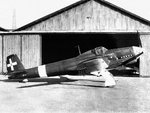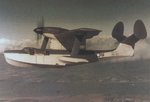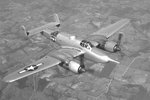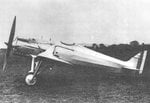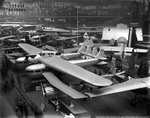- Thread starter
- #21
Airspeed A.S.39 Fleet Shadower designed as a maritime patrol aircraft in 1939, never reached production. The AS 39 was developed under specifications S.23/27 for a slow, long-range patrol aircraft for ultimate service with the Royal Navy. Specification S.22/37 was written around Operational Requirement OR.52, the type of aircraft envisaged was a 3 seater capable of operating from an aircraft carrier flight deck. It was built to a requirement for an aircraft capable of shadowing enemy fleets at night, that demanded a slow-flying, silent aircraft with a long range. A high-wing aircraft with fixed landing gear, an obervation post in the nose, and four small engines distributed along the wing to generate lift. There were 5 companies interested in this specification, Percival, Short Bros, Fairey, General Aircraft and Airspeed.
The AS 39 was a high-wing monoplane of mixed construction with the wings of wooden construction with two spruce and plywood box spars, former ribs, and a plywood covering. Sections between the spars were watertight to provide buoyancy in the event of a forced-alighting at sea. Wing bracing struts each consist of two steel tubes arranged in Vee formation. The fuselage is of metal construction with a detachable forward observer's compartment. The undercarriage consisted of a conventual fixed type. The AS 39 was powered by four 130 hp Pobjoy Niagara V seven-cylinder radial air-cooled geared engines, each driving a two-blade fixed-pitch wooden airscrew 8 ft. in diameter. The crew of the AS 39 consisted of a Pilot, observer and radio-operator.
Two prototypes of the A.S.39 were ordered, N1323 and N1324, but only one was completed, N1323 being flown on 17/10/40, later than the GAL. 38 as it awaited the arrival of Niagara V's. In common with the GAL.38, the aircraft's performance during flight trials was disappointing due to aerodynamical problems, particularly when one engine was cut. In the end this aircraft like the GAL 38, no longer served a viable purpose.
The AS 39 was a high-wing monoplane of mixed construction with the wings of wooden construction with two spruce and plywood box spars, former ribs, and a plywood covering. Sections between the spars were watertight to provide buoyancy in the event of a forced-alighting at sea. Wing bracing struts each consist of two steel tubes arranged in Vee formation. The fuselage is of metal construction with a detachable forward observer's compartment. The undercarriage consisted of a conventual fixed type. The AS 39 was powered by four 130 hp Pobjoy Niagara V seven-cylinder radial air-cooled geared engines, each driving a two-blade fixed-pitch wooden airscrew 8 ft. in diameter. The crew of the AS 39 consisted of a Pilot, observer and radio-operator.
Two prototypes of the A.S.39 were ordered, N1323 and N1324, but only one was completed, N1323 being flown on 17/10/40, later than the GAL. 38 as it awaited the arrival of Niagara V's. In common with the GAL.38, the aircraft's performance during flight trials was disappointing due to aerodynamical problems, particularly when one engine was cut. In the end this aircraft like the GAL 38, no longer served a viable purpose.










